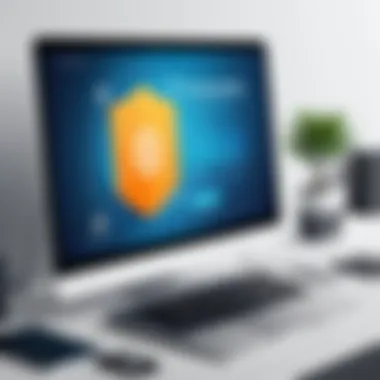Mastering Safe Internet Practices for Today’s Users


Intro
As our lives increasingly revolve around the digital realm, the necessity for safe internet surfing cannot be overstated. With each click, we expose ourselves to threats that can compromise personal information, finances, and overall security. This guide aims to unravel the complex web of online safety, equipping you with the knowledge and tools to navigate the digital landscape securely. In the sections that follow, we will delve deeper into various cybersecurity threats, best practices, privacy concerns, necessary technologies, and the importance of continued education in this ever-shifting environment.
Cybersecurity Threats and Trends
In today’s interconnected world, the dangers lurking in the shadows of the internet have evolved at breakneck speed.
Notable cybersecurity threats in the digital landscape
Cyber threats are a constant presence, morphing and adapting as technology advances. From classic malware to sophisticated ransomware, these threats take various forms.
- Malware: Software intentionally designed to cause damage to a computer, server, or network.
- Ransomware: A form of malware that encrypts the victim's files and demands a ransom.
- Phishing Scams: Deceptive attempts to obtain sensitive information, often disguised as legitimate requests.
- Denial of Service (DoS) Attacks: Flooding a network with traffic to overload systems and render them unusable.
Recognizing these dangers requires vigilance and a proactive approach.
Emerging trends in cyber attacks and vulnerabilities
As technology evolves, so do the tactics employed by cybercriminals. Recent shifts highlight striking trends:
- Increased use of Artificial Intelligence: Cybercriminals leverage AI technologies to automate attacks and enhance stealth.
- Targeting the Internet of Things (IoT): With the rise of smart devices, hackers now have more potential entry points.
- Social Engineering: Manipulating people into breaking security protocols becomes ever more sophisticated.
By keeping up with these trends, users can better prepare themselves for potential threats.
Impact of cyber threats on individuals and businesses
Cybersecurity threats can bear severe consequences. Individuals may face identity theft, financial loss, and emotional distress. For businesses, the stakes are even higher. A data breach could mean hefty fines, loss of reputation, and even the potential for bankruptcy.
"In the digital age, your information is both a currency and a target; safeguarding it is non-negotiable."
Best Practices for Cybersecurity
Implementing best practices in cybersecurity is essential for everyone, whether a tech veteran or a casual user.
Importance of strong password management
One of the simplest yet most effective ways to secure accounts is through robust password management. Avoid using easily guessable passwords like "123456" or your name. Instead, opt for a mix of letters, numbers, and symbols, ensuring that each password is unique to different accounts. Using a password manager can facilitate this process.
Implementing multi-factor authentication for enhanced security
Multi-factor authentication adds an extra layer of security by requiring additional verification methods beyond just a password. This could include a text message with a code or an authentication app notification.
Regular software updates and patches for protection
Software developers consistently release updates to fix vulnerabilities. Ignoring updates can leave systems exposed. Setting your devices to update automatically can help mitigate this risk.
Secure online browsing habits and email practices
Practice safe browsing by avoiding untrusted websites and ensuring that URLs begin with "https://". Email practices also matter; be cautious of unsolicited emails and attachments, as these are common vectors for malware.
Privacy and Data Protection
Data privacy is increasingly a priority in our data-driven world. It's vital to understand the measures that can enhance your privacy.
Importance of data encryption for privacy
Data encryption translates information into a secure format that can only be read or processed after decryption. Utilizing encryption tools safeguards sensitive data from prying eyes.
Risks associated with sharing personal information online
Oversharing on social media and other platforms can lead to identity theft and other risks. Make it a habit to review privacy settings and limit access to personal information.
Strategies for safeguarding sensitive data and personal details
- Use encryption tools for file storage.
- Regularly audit online accounts for unnecessary personal info.
- Shutdown or restrict access to accounts no longer in use.
Security Technologies and Tools
In a tech-savvy world, harnessing the right tools can significantly bolster your defense against online threats.
Overview of key cybersecurity tools and software
An array of software solutions exists to enhance cybersecurity measures:
- Antivirus programs: Protect against malware.
- Firewalls: Act as a barrier between your secure network and threats from the internet.
- VPNs: Encrypt data transfers, keeping online activity private and secure.
Benefits of using antivirus programs and firewalls
Antivirus programs regularly scan for threats, while firewalls filter incoming and outgoing network traffic. Together, they form a foundational layer of your cybersecurity strategy.
Application of Virtual Private Networks (VPNs) for secure data transmission
A VPN serves to mask your IP address and encrypt your online activities, making it harder for hackers and snoopers to intercept your data. This is especially important when using public Wi-Fi networks.
Cybersecurity Awareness and Education


As technology continuously evolves, so too should our understanding of cybersecurity.
Educating individuals on recognizing phishing attempts
Being able to identify phishing signals is crucial. Look for:
- Poor spelling and grammar in emails
- A sense of urgency in requests for information
- Unfamiliar email addresses
Promoting cybersecurity awareness in the digital age
Everyone, from everyday users to corporate employees, must be educated on current cybersecurity practices. Businesses, in particular, should make it a priority through regular training sessions.
Resources for learning about cybersecurity fundamentals
Several platforms and websites offer excellent cybersecurity education:
- Coursera
- edX
- Khan Academy
- NIST's Cybersecurity Framework
By understanding the risks and adopting effective strategies, individuals and organizations alike can significantly improve their cybersecurity posture, ensuring a safer online experience.
Understanding Online Risks
In the vast and ever-evolving landscape of the internet, understanding online risks is paramount for anyone looking to navigate safely. With the convenience of the digital world comes an array of potential dangers that can compromise not only personal information but also financial security.
The Importance of Online Safety
Having a grasp on online safety means being aware of the pitfalls that wait around every virtual corner. It serves as a form of self-defense, especially in an age where data is deemed the new oil. By understanding these risks, individuals and professionals can better protect themselves and their interests. The implications of lax security can be dire, leading to identity theft, financial loss, or worse, tarnishing one's reputation online.
Understanding these risks isn't just about adopting a few precautionary measures; it's about integrating a security-first mindset into your daily digital interactions. This proactive approach helps in recognizing red flags and potential threats before they escalate into serious issues.
Common Threats in the Digital Space
The web can often feel like a two-edged sword. While it offers immense freedom and information, it also harbors common threats that can ensnare the unsuspecting user. Recognizing these threats is key to a safer online experience. Here are a few of the more prevalent risks:
Malware
Malware is like a digital unwanted guest—uninvited and capable of causing significant disruption. Its primary role is to infiltrate systems in secret and execute harmful actions. From stealing sensitive data to corrupting files, malware comes in various forms, including viruses, worms, and ransomware. The key characteristic of malware is its ability to evolve quickly, adapting to user behaviors and security measures.
The uniqueness of malware lies in its diverse payloads and delivery methods, making it a popular choice for cybercriminals. For instance, ransomware can encrypt files, making them useless until a ransom is paid. This multifaceted approach makes it dangerous, and combating it requires constant vigilance and updated security measures.
Phishing
Phishing is akin to a cleverly disguised trap set to ensnare the unwary. Email scams, fake websites, and even deceptive social media messages are all tactics employed by cybercriminals to obtain sensitive data. The key characteristic of phishing is its ability to mimic legitimate entities, making it incredibly deceptive.
What makes phishing particularly concerning is its capacity for mass targeting. A single scam email can reach thousands, increasing the odds of finding a victim. Users must cultivate a discerning eye—checking URLs, scrutinizing attachments, and being wary of unsolicited messages can go a long way in avoiding these traps.
Data Breaches
Data breaches can feel like a thunderbolt out of the blue. They occur when an unauthorized party gains access to sensitive information, often leading to significant repercussions for businesses and individuals alike. A defining feature of data breaches is their ability to affect vast numbers of people at once, as seen in high-profile incidents involving large corporations.
The fallout from data breaches can be overwhelming. Individuals may see compromised personal information, while companies face steep fines, loss of customer trust, and the long, arduous process of damage control. Being aware of data breach reports and routinely updating passwords are critical steps individuals can take to mitigate potential damage to their data.
Identity Theft
Identity theft is the ultimate violation of privacy in the digital realm. It occurs when someone pretends to be another person, typically to obtain credit, loans, or other financial benefits. The heart of identity theft lies in its stealth and the profound impact it can have—leading to financial ruin for many.
The ease with which personal information can be stolen is both a blessing and a curse of the internet. With a few data points, a thief can assume another’s identity, creating liabilities that are often challenging to rectify. Understanding how identity theft happens and taking measures to safeguard personal information can empower users to protect their identities.
"The best defense is a good offense; staying informed about potential online risks makes all the difference."
In summary, recognizing these common threats forms the cornerstone of online safety. As users become more educated about online risks, the digital world can shift from a treacherous terrain to a space that fosters productive and secure experiences.
Establishing a Secure Environment
Creating a secure environment is crucial in the quest for safe internet surfing. It acts as a solid foundation upon which other security measures can be built. In this digital age, the risks of cyber threats loom large. Thus, setting up a secure online environment isn't just a luxury; it's a necessity.
Being proactive in this approach can lessen the chances of falling prey to malicious actors. Security isn’t something you can set and forget; it requires regular assessments and upgrades to adapt to the ever-changing landscape. This section will go into vital aspects, such as choosing a secure connection and understanding the role of firewalls.
Choosing a Secure Connection
To kick things off, let’s talk about securing your connection. A secure connection is your first line of defense. Think of it as the fortified door of your digital home. Here are two key aspects to consider:
Wi-Fi Networks
Wi-Fi networks are incredibly convenient. They allow us to connect multiple devices with ease. The primary characteristic of Wi-Fi is its untethered freedom; however, with that freedom comes a price. When properly secured, Wi-Fi can be a beneficial choice for users. Employing technologies like WPA3 encryption can significantly bolster network safety.
It's essential to use a strong password for your router.
Advantages of Wi-Fi Networks:
- Convenience: Easy access from various devices.
- Flexibility: Multiple users can connect with ease.
But there are also pitfalls, especially if the network is not adequately protected.
- Risks: Open networks can expose users to eavesdropping and man-in-the-middle attacks.


Avoiding Public Wi-Fi
Public Wi-Fi is more common than you think, found in cafes, airports, and hotels. The attraction of quick, free internet is undeniable. However, avoiding public Wi-Fi is often wise. The distinctive feature here is the susceptibility of public networks to exploitation; it serves as a playground for hackers.
Opting to steer clear of these networks significantly decreases the odds of data theft.
Why Avoid Public Wi-Fi?
- Unsecure: Many public networks do not require passwords or use simple ones.
- Privacy Risks: Your data can easily be intercepted.
While the allure of public Wi-Fi is strong, it’s generally a gamble with your personal information. Safer alternatives, like mobile hot spots or VPNs, can provide secure access while you're out and about.
The Role of Firewalls
Now let’s touch on firewalls, the unsung heroes in cybersecurity. Think of firewalls as the gatekeepers of your network. They monitor incoming and outgoing traffic, deciding what is allowed through. Active monitoring of network traffic can deter many potential threats before they ever reach your devices.
Having a firewall installed is simple yet powerful. Many operating systems come with a built-in firewall, which can generally be set to high security. Additionally, hardware firewalls provide a broader shield against external attacks. It's important to note that while firewalls are effective, they aren't foolproof. Updating and configuring your firewall settings periodically is a wise practice.
"A firewall is like a moat around your digital castle; it won't stop everything, but it can keep out the riffraff."
In summary, establishing a secure environment lays the groundwork for robust online safety. From choosing the right connections to utilizing firewalls effectively, each decision strengthens your defense against the myriad of online risks. By being diligent in these efforts, you create a barrier that not only protects your data but also your peace of mind.
Employing Secure Practices
In today’s increasingly digital landscape, strengthening security protocols isn't just important; it’s vital. The act of employing secure practices is like setting guardrails on the highway of the internet—you want to stay on the right track and avoid any potential pitfalls. This section dives deep into essential strategies that can empower users with a robust safety net while navigating the web.
Using Strong Passwords
Often regarded as the front door to your online life, passwords hold immense power. A strong password is like a good lock; it keeps the undesirable elements at bay. However, crafting a memorable yet secure password can be a tall order. This is where password managers come into play.
Password Managers
Password managers take the hard work out of remembering every complex password. They act like a digital vault, storing and encrypting your passwords. One key characteristic of password managers is their ability to generate random, complex passwords, eliminating the human element of choosing weak or easily guessable passwords.
Using one can considerably reduce the risk of someone breaking into your accounts. Their convenience is a major selling point—once you set it up, you only need to remember one master password. However, a downside could be that if someone gains access to your master password, they could potentially access everything. Thus, while password managers do substantially enhance security, users must maintain a high level of caution.
Two-Factor Authentication
Two-factor authentication (2FA) is a terrific way to double your security. As its name suggests, it involves two different methods of verifying your identity before you gain access to your accounts. The first is usually your password; the second could be something you possess, such as a smartphone or a hardware token. One critical feature of 2FA is its ability to thwart unauthorized access even if your password has been compromised.
This extra layer of security is rapidly becoming a best practice and is favored by many. It significantly reduces the likelihood of an attack succeeding. However, it can present some inconveniences—for instance, if you lose your phone, accessing your account might be a hassle. Nevertheless, the benefits of enabling 2FA far outweigh these minor drawbacks.
How to Manage Cookies
Cookies are another crucial aspect of secure browsing environment. They are little files that websites store on your computer to remember preferences and information. While cookies can enhance user experience by personalizing content, not managing them properly can expose individuals to privacy risks.
To manage cookies, use your browser settings to regularly clear out old or unnecessary cookies. Also, consider adjusting privacy settings to limit tracking cookies from advertisers. Striking a balance between convenience and privacy is essential; it can be akin to finding the right spice level in a dish—you want just enough flavor without overwhelming the palette.
Regularly reviewing cookie settings can lead to a safer and more personalized internet experience.
In summary, employing secure practices is fundamental for anyone wishing to maintain their digital integrity. Strong passwords—and the use of password managers coupled with two-factor authentication—lay the groundwork for a robust security strategy. Awareness and proactive management of cookies further enhance the security measures in place. Moving forward, users must always stay vigilant, continually refining their approach to digital safety.
Enhancing Privacy with Tools
In today’s digital landscape, protecting one’s privacy is a paramount concern. Tools that enhance privacy serve as a shield, safeguarding personal information from prying eyes. The digital realm is rife with data collection practices, making it essential for users to consciously decide what information they will share. Using privacy tools not only helps in controlling exposure but also in securing online activities against unauthorized monitoring. By employing these tools, individuals can browse the internet with a sense of security and anonymity.
Virtual Private Networks (VPNs)
Benefits of Using a VPN
Utilizing a VPN has become increasingly popular due to its significant benefits in enhancing online privacy. At its core, a VPN encrypts your internet traffic, creating a secure tunnel between your device and the internet. This encryption is a key characteristic, effectively disguising your online activities from ISPs and malicious entities. When one connects to a VPN, their IP address is masked, making it appear as though they are accessing the internet from a different location.
The advantage is clear: it becomes immensely dificult for cybercriminals to trace back to the original user. Moreover, a VPN can also help in bypassing geographic restrictions, allowing users to access content that may be blocked in their region.
However, it’s important to remember that not all VPNs are created equal. Some might log user data or provide inadequate encryption, which could counteract the benefits. Therefore, careful consideration is needed when choosing a service that aligns with the goal of enhancing privacy.
Choosing the Right VPN Service
Selecting a VPN service is a decision that requires attention to detail. The first step is to assess what you need a VPN for—be it streaming, security, or accessing sensitive information. A crucial feature to look for is a no-logs policy, meaning the service does not keep records of your activities. This is vital for maintaining anonymity.
Another important aspect is the level of encryption offered. Strong encryption is a non-negotiable factor; otherwise, it could expose you to risks. Beyond that, the user experience is also worth considering. A user-friendly interface can make your online experience seamless and more enjoyable.
While there are free VPN options available, they often come with limitations such as slower speeds, ads, and potential data harvesting. In many cases, investing in a reputable paid service provides a more secure and effective experience.
Using Tor Browser
The Tor Browser provides an alternative means to enhance privacy while online. What sets it apart is its method of routing internet traffic through multiple servers, which drastically improves user anonymity. Each layer of the network is protected, making it almost impossible for anyone to trace the origin of the data.
While Tor is a powerful tool, it does come with its own set of challenges. The browsing speed is typically slower than conventional browsers due to the increased routing process. Furthermore, some websites may block access to users coming from the Tor network, limiting its usability.
Overall, incorporating tools such as VPNs and Tor Browser into your internet usage routine can significantly bolster your privacy and online security. With the right information and resources, you can take control of your online presence, ensuring a safer surfing experience.
Recognizing Scams and Fraud
Recognizing scams and fraud is an integral part of staying safe while navigating the digital landscape. The internet provides an ease of access like never before, but it also opens the door to various cons and tricks that can lead to unforeseen consequences. Identifying scams helps in protecting personal information, finances, and mental well-being. In this section, we will explore the warning signs of phishing attempts and the dangers posed by unsolicited offers, aiding you in honing your skills to spot deceitful practices online.


Identifying Phishing Attempts
Identifying phishing attempts is crucial, as it allows users to safeguard their sensitive information from falling into the hands of cybercriminals. Phishing scams usually come in the form of deceptive emails or messages that look legitimate but are meant to trick you into revealing personal details.
Email Scams
Email scams, the juggernaut of phishing tactics, rely heavily on mimicking familiar brands to gain trust. A classic characteristic of these scams is how they often create a sense of urgency. Phrases like "Your account will be locked unless you act now!" push individuals into a panicked response. This sense of immediacy is strategic, as many people, under pressure, might bypass their critical thinking skills.
The unique feature of these email scams lies in their hyperlinks, which often lead to fake websites. Once you enter any personal information on these deceptive platforms, it's generally captured by the fraudsters. This tactic is beneficial for scammers because it requires minimal effort on their part to target numerous individuals at once. However, that’s a double-edged sword. Many email services now come integrated with advanced filtering tools designed to detect and eliminate these threats, making it crucial for users to familiarize themselves with these features.
Fake Websites
Fake websites take deception to another level, acting as facsimiles of trusted sites. Scammers often invest in creating websites that bear a striking resemblance to legitimate companies. Their key characteristic is that they tend to imitate the look and feel of authentic pages closely, making it easy for an unsuspecting user to fall prey to their tricks. These phony sites usually feature attractive offers or products, drawing in individuals looking for a deal.
What sets fake sites apart is often their domain names. A slight alteration, like substituting a letter or using an unexpected extension, can make a false site hard to spot. Their advantage lies in the fact that unsuspecting visitors input sensitive data without realizing that they are on a fraudulent site. Users should aim to examine the URL closely before engaging with any site, paying attention to small details. Browser security features can also aid in identifying whether a site is secure, so staying informed of those can provide an extra layer of safety.
The Dangers of Unsolicited Offers
Unsolicited offers often appear benign on the surface but can carry significant risks. These offers, whether they come via email, social media, or text messages, frequently lure individuals in with enticing discounts or exclusive access to services. It's a common fallacy to perceive something that sounds unusually good as legitimate.
A notable danger with unsolicited offers is that they can lead to more phishing attempts once scammers gain even a little trust. Once engaged, they may follow up with requests for additional information, seeking to exploit any personal data users inadvertently provide. It's essential for users to maintain a skeptical mindset when encountering offers that seem too good to be true, as it shields them from potential financial loss and identity theft. By staying vigilant and questioning the authenticity of unsolicited messages or deals, one can navigate the digital realm with greater confidence.
Utilizing Cybersecurity Software
Navigating the internet without adequate protection is like sailing a ship without a compass. The digital realm is fraught with dangers that can take a hefty toll on both individuals and organizations. To combat these lurking threats, utilizing cybersecurity software is not just a recommendation – it's a necessity. When employed effectively, these digital shields can help bolster one's defenses against cyber intrusions, safeguarding sensitive information and ensuring peace of mind during online activities.
Antivirus Solutions
Antivirus solutions serve as the frontline defense against malicious attacks. These software programs are designed to search, detect, and eradicate various forms of malware, including viruses, worms, and trojans. But how do they really work? In simpler terms, they continuously monitor your device for signs of harmful activities.
- Real-Time Protection: A big draw of modern antivirus programs is their real-time scanning capability. This feature means that as you download files or click links, the software instantly checks for any threats. If something fishy pops up, it alerts you quicker than you can say "Jack Robinson."
- Regular Updates: Cybercriminals keep evolving their tactics, constantly inventing new ways to infiltrate systems. That's where the software's frequent updates come in handy. Regular updates equip your antivirus with the latest virus definitions, giving it a sharper edge against newer threats. Ignoring these updates is like going into battle without the latest intelligence reports.
- User-Friendly Interfaces: Nowadays, many antivirus solutions come with intuitive designs, making it so even someone who wasn't born with a mouse in their hand can navigate the settings. This accessibility is crucial because no one wants to feel like they're staring at a complex calculus equation when trying to protect their data.
A few prominent players in the antivirus arena include McAfee, Norton, and Bitdefender. Each has distinct features tailored to cater to various user needs. Choosing the right one boils down to individual requirements, such as the type of device and level of protection needed.
Malware Detection Tools
When it comes to cybersecurity, the importance of malware detection tools cannot be overlooked. These tools go beyond what traditional antivirus programs offer by providing a more comprehensive approach to identifying potential threats. Consider them like the undercover detectives of the digital world, constantly on the lookout for suspicious behavior that might signal a breach or infection.
- Behavioral Analysis: An intriguing technique utilized by many malware detection tools is behavioral analysis. Rather than solely relying on known virus signatures, these programs observe how programs behave on your computer. If a legitimate application suddenly starts acting like it’s up to no good, the tool raises the alarm. Think of it as a parent watching their child’s friends; just because they seem nice doesn't mean they won't get your kid into trouble!
- Heuristic Detection: Another vital feature is heuristic detection, which involves examining the code of files and programs to determine whether they might exhibit malicious behavior. While some initial warnings might feel like guessing at a game of 20 questions, it’s a proactive approach that can thwart threats before they manifest.
- Comprehensive Reporting: High-quality malware detection tools also offer comprehensive reporting features. This way, users can see a detailed analysis of detected threats, helping them understand potential vulnerabilities and adjust their online behaviors accordingly. Transparency is key here; knowing what’s lurking in the digital shadows allows for informed decisions.
"An ounce of prevention is worth a pound of cure."
By incorporating both antivirus solutions and malware detection tools into one’s online arsenal, users can create a layered defense strategy against the multifaceted threats of the internet. The landscape of cybersecurity is constantly changing, and remaining vigilant is crucial in this battle against ever-evolving threats. No one wants to leave the digital door wide open, inviting trouble in. Taking these proactive measures is essential for a safer, more secure online experience.
Educating Yourself and Others
In the sprawling terrain of the digital realm, knowledge is often the best defense against a myriad of online threats. As such, educating oneself and extending that knowledge to others is not just beneficial – it's essential. With the internet's ever-expanding influence on communication, commerce, and information sharing, understanding the intricacies of online safety becomes a priority for everyone, from seasoned professionals in the IT sector to everyday users who simply like to browse the web.
Staying informed about cyber threats is a foundational element in this educational journey. No one can claim to be truly secure if they don’t comprehend what they’re up against. Regularly updated resources such as cybersecurity websites or forums can provide insights into the latest tactics employed by cybercriminals. For instance, reading articles on platforms like Wikipedia or engaging in discussions on Reddit can enhance understanding and awareness of emerging threats. Staying informed helps individuals in recognizing potential scams or vulnerabilities before they can be exploited.
Furthermore, the digital safety landscape is not static; it evolves continually as technology and methods used by malicious entities progress. Thus, education must be a dynamic process of lifelong learning. Just as one might keep abreast of changes in local laws or new findings in their professional field, online safety courses and workshops could equip users with necessary skills and tools to better protect themselves.
"Knowledge is power when it comes to online safety; keep yourself armed with the latest information."
The Importance of Knowledge Sharing
When individual education is prioritized, the benefits rear their valuable heads in the larger community. Encouraging knowledge sharing can transform basic awareness into a collective defense mechanism against cyber threats. When one person shares what they know – be it through a workshop at a local community center or a simple conversation over coffee – it can resonate through friends, family, and colleagues.
Moreover, sharing personal experiences can add layers of understanding. Perhaps someone encountered a phishing email that, at first glance, seemed legitimate. By discussing the incident, that person can help others identify similar scams in the future, potentially preventing them from falling victim to the same trap. The ripple effect of knowledge sharing can create a well-informed populace, much like a neighborhood watch but for cyberspace.
Here's a thought: consider creating a group chat or forum where information about new threats can be rapidly disseminated. This proactive approach can cultivate a culture of vigilance.
To summarize, educating yourself and others about online safety is not merely an obligation but a proactive measure. The more informed individuals are, the better equipped they become to ward off potential threats. This concept of education extends beyond personal benefit into the realm of community responsibility, resulting in a fortified defense against the evolving landscape of cybercrime.
The End and Best Practices
In this ever-changing digital landscape, it's crystal clear that online safety is a crucial issue that everyone must take seriously. The internet, while a treasure trove of information and communication, is also home to numerous threats lurking in the shadows. This article has elaborated on various strategies, tools, and practices that can serve as a sturdy lifeline as you navigate the web. By understanding concepts like strong passwords, the significance of VPNs, and the necessity of cybersecurity software, users can arm themselves against potential dangers.
The conclusion serves not just as a wrap-up but as a call to action for readers. Embracing the suggested best practices can significantly reduce the risk of falling victim to online threats. Achieving real safety online isn't a one-time effort but rather an ongoing commitment that requires regular updates and vigilance.
"It's not just about knowing the risks; it's about taking tangible steps to safeguard your digital life."
By being proactive and staying informed, you can ensure a more secure online experience, safeguarding your information from malicious attacks and enhancing your online privacy.
Recap of Key Security Measures
To tie everything together, here’s a brief recap of the pivotal security measures described throughout the article:
- Use Strong Passwords: Ensure your passwords are complex and unique. Consider employing a password manager to keep everything organized.
- Enable Two-Factor Authentication: Adding an extra layer of security can drastically reduce the likelihood of unauthorized access.
- Secure your Wi-Fi Connection: Always use encrypted Wi-Fi networks and be wary of public connections.
- Regularly Update Software: Keeping your operating systems and applications up-to-date ensures vulnerabilities are patched.
- Utilize VPN Services: Investing in a reputable VPN can help protect your data from snoopers and keep your browsing anonymous.
- Stay Informed: Make it a habit to stay abreast of emerging cyber threats and scams.
Employing these measures can fortify your defenses against potential online threats, making a significant difference in your security posture.
Future Considerations in Online Safety
Looking beyond the immediate security measures, there are several future considerations that can guide our approach to online safety:
- Evolving Threat Landscape: Cyber threats are continually evolving. What’s considered safe today may not be adequate tomorrow.
- Adapting to New Technology: The rise of IoT devices brings new security challenges. As these devices become commonplace, developing security practices specific to them will be essential.
- Ongoing Education: As technology advances, so must our knowledge and practices. Continuous learning about cybersecurity trends, tools, and techniques will be indispensable for all users, not just IT professionals.
- Policy and Legislation: Keep an eye on how regulations around data protection are changing. Compliance not only protects your data but enhances your organization's reputation.
By considering these aspects moving forward, individuals and organizations can remain agile in their security practices, adapting to an ever-changing digital world and enhancing overall internet safety.
Engaging actively with the topic of online security isn't just a good practice; it's critical to maintaining the integrity of personal and organizational data in this digital age.







